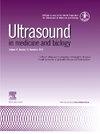Ultrasound and Microbubble Mediated Delivery of Virus-Sensitizing Drugs Improves In Vitro Oncolytic Virotherapy Against Breast Cancer Cells
IF 2.4
3区 医学
Q2 ACOUSTICS
引用次数: 0
Abstract
Objective
Oncolytic virotherapy is an emerging form of cancer treatment that uses replication-competent viruses to kill cancer cells. However, as for other cancer therapies, oncolytic viruses are not effective against all cancers and there is a need to further improve treatment efficacy while maintaining low toxicity. Viral sensitizers are drugs that potentiate viral replication in tumor cells. While various studies have shown their synergy with oncolytic virotherapy, the risks associated with systemic toxicities that vary according to the drug used limit the clinical translation of the approach. In this study, we used an ultrasound and image-guided approach in which we loaded viral-sensitizing drugs onto microbubbles which are then cavitated by ultrasound to deliver the encapsulated drugs to tumor cells, which improves in vitro oncolytic virotherapy efficacy in the 4T1 breast cancer model.
Methods
In this study, we loaded two viral sensitizers, paclitaxel and volasertib, onto lipid microbubbles and comprehensively characterized their effect on the infection of 4T1 murine mammary carcinoma cells by oncolytic Vesicular stomatitis virus in vitro.
Results
We synthesized lipid microbubbles with high and moderate encapsulation efficiency for paclitaxel (83.7%) and volasertib (28.6%), respectively. Stability assessments demonstrated excellent retention in various conditions, highlighting their potential for in vivo use. In vitro studies confirmed their acoustic responsiveness essential for controlled drug release at targeted sites. Paclitaxel and volasertib release from viral sensitizer-loaded microbubbles following ultrasound-triggered cavitation significantly increased viral replication (57-fold, p < 0.0001 and 27-fold, p < 0.01, respectively), as well as tumor cell killing compared to virus-infected untreated cells.
Conclusion
Altogether, our data show that drug-loaded microbubble cavitation and free drugs both sensitize cancer cells to oncolytic viruses to equivalent levels. These findings provide a proof of concept for the use of ultrasound-guided microbubble drug delivery in combination with oncolytic virotherapy.
超声和微泡介导的病毒致敏药物递送改善了体外溶瘤病毒治疗乳腺癌细胞的效果。
目的:溶瘤病毒治疗是一种新兴的癌症治疗形式,它使用具有复制能力的病毒杀死癌细胞。然而,对于其他癌症治疗,溶瘤病毒并不是对所有癌症都有效,需要在保持低毒性的同时进一步提高治疗效果。病毒致敏剂是增强病毒在肿瘤细胞内复制的药物。虽然各种研究表明它们与溶瘤病毒疗法具有协同作用,但根据所使用的药物不同,与全身毒性相关的风险限制了该方法的临床应用。在本研究中,我们采用超声和图像引导的方法,将病毒致敏药物加载到微泡中,然后通过超声空化将包裹的药物输送到肿瘤细胞中,从而提高了4T1乳腺癌模型的体外溶瘤病毒治疗效果。方法:在脂质微泡上加载两种病毒增敏剂紫杉醇和volasertib,综合表征其对体外溶瘤性水泡性口炎病毒感染4T1小鼠乳腺癌细胞的影响。结果:合成的脂质微泡对紫杉醇(83.7%)和沃拉塞替(28.6%)分别具有较高和中等的包封率。稳定性评估表明在各种条件下保持良好,突出了它们在体内使用的潜力。体外研究证实了它们的声学响应性对于控制药物在目标部位的释放至关重要。超声触发空化后,载有病毒敏化剂的微泡释放的紫杉醇和volasertib显著增加了病毒复制(分别为57倍,p < 0.0001和27倍,p < 0.01),以及与病毒感染的未处理细胞相比的肿瘤细胞杀伤。结论:总的来说,我们的数据表明,载药微泡空化和游离药物对溶瘤病毒的敏感性都达到了相同的水平。这些发现为超声引导微泡给药联合溶瘤病毒治疗提供了概念证明。
本文章由计算机程序翻译,如有差异,请以英文原文为准。
求助全文
约1分钟内获得全文
求助全文
来源期刊
CiteScore
6.20
自引率
6.90%
发文量
325
审稿时长
70 days
期刊介绍:
Ultrasound in Medicine and Biology is the official journal of the World Federation for Ultrasound in Medicine and Biology. The journal publishes original contributions that demonstrate a novel application of an existing ultrasound technology in clinical diagnostic, interventional and therapeutic applications, new and improved clinical techniques, the physics, engineering and technology of ultrasound in medicine and biology, and the interactions between ultrasound and biological systems, including bioeffects. Papers that simply utilize standard diagnostic ultrasound as a measuring tool will be considered out of scope. Extended critical reviews of subjects of contemporary interest in the field are also published, in addition to occasional editorial articles, clinical and technical notes, book reviews, letters to the editor and a calendar of forthcoming meetings. It is the aim of the journal fully to meet the information and publication requirements of the clinicians, scientists, engineers and other professionals who constitute the biomedical ultrasonic community.

 求助内容:
求助内容: 应助结果提醒方式:
应助结果提醒方式:


